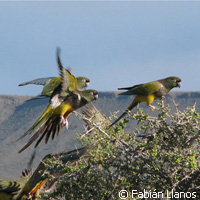The parrots that crossed the Andes
Due to its hostile terrain, the South American Andes are normally a no-go area for various birds. Species that live on both sides of the mountain range in more moderate climates only cross this treacherous environment of glaciers, salty deserts and high elevation steppes on rare occasions, if at all. But now, European researchers have discovered that the ancestors of the burrowing parrot (Cyanoliseus patagonus) occupied what is today Chile, and from there made a single successful crossing of the Andes. The scientists hail from the University of Freiburg and the Max Planck Institute for Ornithology in Germany and the Konrad Lorenz Institute for Ethology in Vienna, Austria. By analysing the genetic make-up of the burrowing parrots' ancestors, the team were able to investigate how animal species overcome natural barriers and expand to suitable habitats; they are tied to specific places for breeding, thus restricting the number of breeding sites. 'The results are fascinating,' comments one of the researchers Juan F. Masello from the Max Planck Institute for Ornithology. 'Contrary to our expectations, the ancestral population originated on the Pacific side of the Andes, where Chile is now, and where there are only small colonies at present. From there, this species managed to successfully cross the Andes on a single occasion. The two Argentinean sub-species originated from this starting population. One of them successfully expanded along rivers until reaching the Atlantic Ocean, where the largest colonies of the species can presently be found. In El Cóndor, this species forms the largest parrot colony in the world, with more than 35,000 breeding pairs.' Burrowing parrots are colourful creatures that breed in colonies situated high up in cliffs of sandstone or limestone. The ravines with the colonies are usually located along rivers and in the valleys at both sides of the Andes, as well as along the cliffs of the Atlantic coast. The researchers carried out 2 surveys of more than 13,000 kilometres, and they unearthed 66 colonies of burrowing parrots from which they collected naturally moulted feathers. The researchers were then able to decode relationships among individual colonies using genetic material extracted from these feathers. 'The genetic data were brought into a timeframe using the age of fossils', says Petra Quillfeldt, also from the Max Planck Institute for Ornithology. 'This way, we were able to estimate that the crossing of the Andes occurred more than 120,000 years ago.' The team estimate that this crossing probably took place in the area of the high Andes close to the Aconcagua (6,962 metres above sea level), probably over a pass of more than 3,000 metres of altitude. The findings from this study will also go some way to protecting and improving conservation of the different sub-species. The Chilean sub-species is an example: under threat from extinction, only 5,000 to 6,000 of these birds remain. Unfortunately, many are still caught and sold as pets. Strengthening conservation measures is even more vital due to the strong genetic differences between different Chilean sub-species. Similarly, in Argentina the northern sub-species is under threat, with only 2,000 breeding pairs left in the wild. The numerically largest sub-species, occurring in Patagonia (southern Argentina), is threatened by habitat destruction, as the steppes are rapidly cleared for the production of soya.For more information, please visit:Max Planck Institute for Ornithology:http://www.orn.mpg.de/index_en.html
Countries
Argentina, Austria, Chile, Germany



